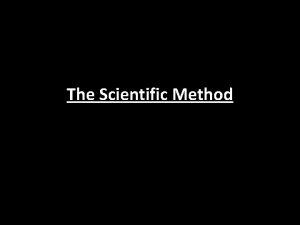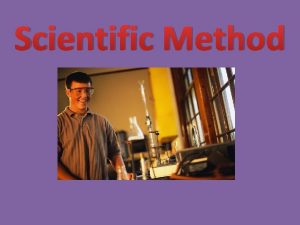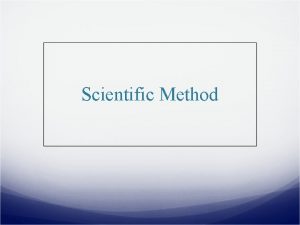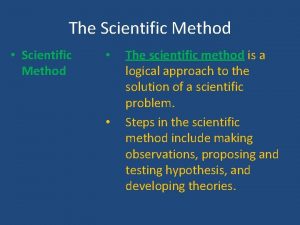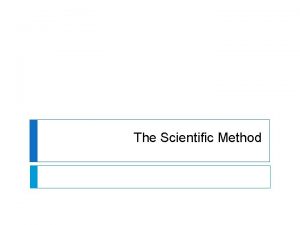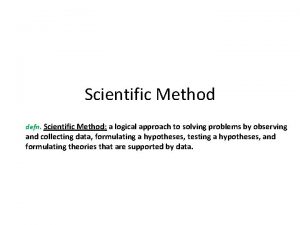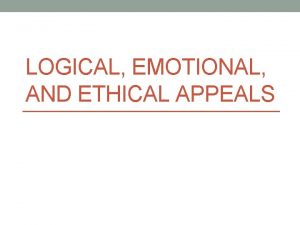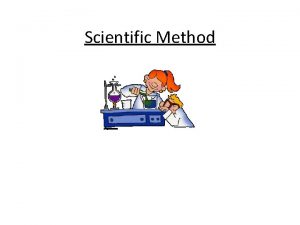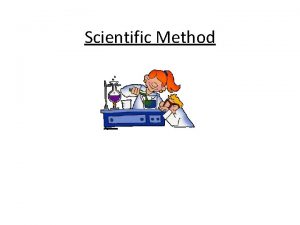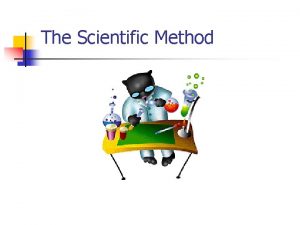Scientific Method The scientific method is a logical




































- Slides: 36


Scientific Method The scientific method is a logical approach to solving problems by observing and collecting data, formulating hypotheses, testing hypotheses, and formulating theories that are supported by data.

Observing and Collecting Data • Observing is the use of the senses to obtain information. • data may be • qualitative (descriptive) • quantitative (numerical) • A system is a specific portion of matter in a given region of space that has been selected for study during an experiment or observation.

Formulating Hypotheses • Scientists use generalizations about the data to formulate a hypothesis, or testable statement. Hypotheses are often “if-then” statements.

OMG! What is THAT Mrs. Beane? !?

Experimentation • Controls are the experimental conditions that remain constant. • Variables are any experimental conditions that change.

Drawing Conclusions • A model in science is more than a physical object; it is often an explanation of how phenomena occur and how data or events are related. • visual, verbal, or mathematical • example: atomic model of matter • A theory is a broad generalization that explains a body of facts or phenomena. example: atomic theory

Scientific Method

Units of Measurements represent quantities. A quantity is something that has magnitude, size, or amount. measurement quantity the teaspoon is a unit of measurement volume is a quantity

Scientists all over the world have agreed on a single measurement system called Le Système International d’Unités, abbreviated SI. There are seven SI base units Meter (m) – length Kilogram (kg) – mass Kelvin (K) – temperature Mole (mol) – amount of substance Candela (cd) – luminous intensity Ampere (A) – current Second (s) - time


Derived SI Units

Density is the ratio of mass to volume, or mass divided by volume. D=m V D = density m= mass V = volume The derived SI unit is kilograms per cubic meter, kg/m 3 g/cm 3 or g/m. L are also used Density is a characteristic physical property of a substance.

Density

Practice Problem A sample of aluminum metal has a mass of 8. 4 g. The volume of the sample is 3. 1 cm 3. Calculate the density of aluminum.

Practice Problem

Conversion Factors A conversion factor is a ratio derived from the equality between two different units that can be used to convert from one unit to the other. Dimensional analysis is a mathematical technique that allows you to use units to solve problems involving measurements. quantity sought = quantity given conversion factor

Dimensional Analysis

Practice Problem Express a mass of 5. 712 grams in milligrams and in kilograms.

Practice Problems

Accuracy and Precision Accuracy refers to the closeness of measurements to the correct or accepted value of the quantity measured. Precision refers to the closeness of a set of measurements of the same quantity made in the same way.

Accuracy and Precision

Percentage Error % error = Your value – Accepted value x 100 Accepted valued

Practice Problem A student measures the mass and volume of a substance and calculates its density as 1. 40 g/m. L. The correct, or accepted, value of the density is 1. 30 g/m. L. What is the percentage error of the student’s measurement?

Practice Problem

Error in Measurement Some error or uncertainty always exists in any measurement. Significant figures in a measurement consist of all the digits known with certainty plus one final digit, which is somewhat uncertain or is estimated.

Significant Figures

Significant Figures

Practice Problem How many significant figures are in each of the following measurements? a. 28. 6 g b. 3440. cm c. 910 m d. 0. 046 04 L e. 0. 006 700 0 kg

Significant Figures When adding or subtracting decimals, the answer must have the same number of digits to the right of the decimal point as there are in the measurement having the fewest digits to the right of the decimal point. For multiplication or division, the answer can have no more significant figures than are in the measurement with the fewest number of significant figures.

Practice Problem Carry out the following calculations. Express each answer to the correct number of significant figures. a. 5. 44 m - 2. 6103 m b. 2. 4 g/m. L 15. 82 m. L

Scientific Notation • In scientific notation, numbers are written in the form M 10 n, where the factor M is a number greater than or equal to 1 but less than 10 and n is a whole number. • Determine M by moving the decimal point in the original number to the left or the right so that only one nonzero digit remains to the left of the decimal point. • Determine n by counting the number of places that you moved the decimal point. If you moved it to the left, n is positive. If you moved it to the right, n is negative.

Scientific Notation Addition and subtraction —These operations can be performed only if the values have the same exponent (n factor). example: 4. 2 104 kg + 7. 9 103 kg Multiplication —The M factors are multiplied, and the exponents are added algebraically. example: (5. 23 106 µm)(7. 1 10 2 µm)

Scientific Notation Division — The M factors are divided, and the exponent of the denominator is subtracted from that of the numerator.

Direct Proportion Two quantities are directly proportional to each other if dividing one by the other gives a constant value.

Inverse Proportion Two quantities are inversely proportional to each other if their product is constant.
 P q logical equivalence
P q logical equivalence Logical equivalence in discrete mathematics
Logical equivalence in discrete mathematics Information gathered during an experiment
Information gathered during an experiment Hình ảnh bộ gõ cơ thể búng tay
Hình ảnh bộ gõ cơ thể búng tay Lp html
Lp html Bổ thể
Bổ thể Tỉ lệ cơ thể trẻ em
Tỉ lệ cơ thể trẻ em Chó sói
Chó sói Thang điểm glasgow
Thang điểm glasgow Hát lên người ơi
Hát lên người ơi Kể tên các môn thể thao
Kể tên các môn thể thao Thế nào là hệ số cao nhất
Thế nào là hệ số cao nhất Các châu lục và đại dương trên thế giới
Các châu lục và đại dương trên thế giới Công thức tính độ biến thiên đông lượng
Công thức tính độ biến thiên đông lượng Trời xanh đây là của chúng ta thể thơ
Trời xanh đây là của chúng ta thể thơ Mật thư anh em như thể tay chân
Mật thư anh em như thể tay chân Làm thế nào để 102-1=99
Làm thế nào để 102-1=99 độ dài liên kết
độ dài liên kết Các châu lục và đại dương trên thế giới
Các châu lục và đại dương trên thế giới Thơ thất ngôn tứ tuyệt đường luật
Thơ thất ngôn tứ tuyệt đường luật Quá trình desamine hóa có thể tạo ra
Quá trình desamine hóa có thể tạo ra Một số thể thơ truyền thống
Một số thể thơ truyền thống Cái miệng bé xinh thế chỉ nói điều hay thôi
Cái miệng bé xinh thế chỉ nói điều hay thôi Vẽ hình chiếu vuông góc của vật thể sau
Vẽ hình chiếu vuông góc của vật thể sau Thế nào là sự mỏi cơ
Thế nào là sự mỏi cơ đặc điểm cơ thể của người tối cổ
đặc điểm cơ thể của người tối cổ Thế nào là giọng cùng tên?
Thế nào là giọng cùng tên? Vẽ hình chiếu đứng bằng cạnh của vật thể
Vẽ hình chiếu đứng bằng cạnh của vật thể Phối cảnh
Phối cảnh Thẻ vin
Thẻ vin đại từ thay thế
đại từ thay thế điện thế nghỉ
điện thế nghỉ Tư thế ngồi viết
Tư thế ngồi viết Diễn thế sinh thái là
Diễn thế sinh thái là Các loại đột biến cấu trúc nhiễm sắc thể
Các loại đột biến cấu trúc nhiễm sắc thể So nguyen to
So nguyen to Tư thế ngồi viết
Tư thế ngồi viết








































